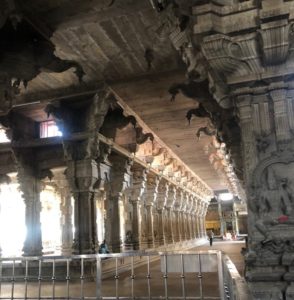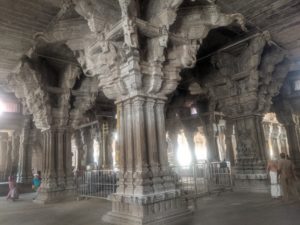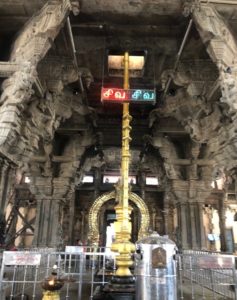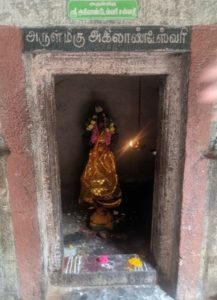The Jambukeswarar temple, situated in Trichy, was built by the Sangam era Chola King, Kochengannan. It is here that Lord Shiva is worshiped as the manifestation of the element, Water.
Jambukeswarar Temple- The Humble Abode of Goddess Akilandeswari

The Jambukeswarar Temple, also known as the Tiruvanaikoil or Tiruvanaikal, is a very old temple with stories dating to antiquity. The historic accounts are related to the early Chola ruler, Kochengannan, who is said to have ruled during the early centuries of the Common Era (CE). The Temple is situated in the Chola heartland of Trichy, in the middle of the island between the rivers Cauvery and its tributary, Coleroon. There are two major temples in this island- Jambukeswarar dedicated to Lord Shiva and Sri Ranganatha Swamy temple dedicated to Lord Vishnu.

There are five Shiva temples called the Panch Bhoot Sthalam that represent him as a manifestation of the five primal elements of nature. This temple represents Shiva as the element Water and the sanctum sanctorum has Appu lingam, signifying water. The other four temples are at Ekambareswarar, Kanchipuram – (earth as Prithvi lingam), Arunachaleswar, Tiruvannamalai – (fire as Agni lingam), Sri Kalahasti – (air as Vayu lingam) and Thillai Nataraja Temple, Chidambaram – (space as Akaash lingam).
Famous Legends Associated With The Temple
There are various legends and traditions related to this temple. The most important one is the story of how this temple got its name, Jambukeswarar. Hindu temples are associated with an indigenous tree called the Sthala Vriksha or the temple tree. The Sthala Vriksha here is the Jamun or rose apple tree. Once Lord Shiva was meditating when Goddess Parvati laughed at him. Lord Shiva asked Goddess Parvati to go to earth and do penance for making this mistake. She was asked to go to a forest of Jamun trees on the banks of the Cauvery River and worship Shiva. Here, Goddess Parvati took some water from the river and turned it into a Shivalinga for her worship.
It so happened that a sage called Jambu Munivar, a Shiva devotee had gone all the way to Mount Kailasha to worship the lord at his abode. He gave a sweet Jamun fruit to Lord Shiva. Lord Shiva ate the fruit and threw the seed. Sage Jambu ate this seed as it was ‘Prasad’ for him. Surprisingly, the seed started to grow within the sage. Lord Shiva told him to go to the Jamun forest on the banks of the Cauvery where Goddess Parvati in the form of Akilandeswari will come to worship a Shivalinga every day. The sage went to the forest and settled near the river while the tree spouted out of his head. Parvati had placed the Shivalinga under this same tree.

Another episode related to this story was also convening at the same time. An elephant named Swadagiri came to this grove every day to wash the Shivalinga with water brought in his trunk from the Cauvery. He would offer fruits and flowers to his Lord. There was a big spider, who was also a Shiva devotee. This spider created a web above the Shivalinga to protect it from sun, rain, and falling leaves. One day the elephant cleaned the web away as he felt it dirtied the area. This angered the spider and it entered the elephant’s trunk and bit inside it. The elephant thrashed its trunk in pain, which killed the spider and also led to his own death. Lord Shiva blessed the elephant’s soul that attained moksha or salvation. The spider, due to its devotion to Lord Shiva, was reborn as a great Chola King – Kochengannan.
Kochengannan was born to King Subadeva and Queen Kamalavati. Astrologers had predicted that if the child is born at a particular time later, then he would rule the world. Despite being in labor, Queen Kamlavati delayed the birth of her son by asking her husband to tie her legs together and keep them in a raised position. The child was thus born in the auspicious time, but his eyes were red, and hence he was named Kochengannan, meaning prince with red eyes. He proved to be a powerful ruler who built at least seventy temples throughout the Tamil land. He was the first to erect a temple for Lord Shiva as Jambukeswarar, his personal deity in his previous birth.
Another legend links this temple to a Chera ruler. A Chera chieftain, Kanaikal Irumborai, was defeated by Kochengannan and was imprisoned in a big fort meant to detain rulers who would not accept Chola suzerainty. The Chera king asked the jailor for water but died before the jailor could bring it. At that time, a renowned Tamil poet, Poikayar, was present in Kochengannan’s court. He presented a poem titled Kalavazhi Narpathu that celebrated the King’s victory over the Chera ruler. Kochengannan wanted to reward the poet with riches, but the poet asked for the release of the Chera king as his reward. Kochengannan agreed, and they went to free the Chera chieftain only to be told by the jailor that the Chera king was no more. Kochengannan got struck with remorse, and it was at this moment that he decided to lead the rest of his life in the worship of Lord Shiva and in building temples. The first temple built by him was in Tiruvanaikal as Jambukeswarar temple.
Building The Shrine- Devotion That Transcends Dynasties
Kochengannan figures in the genealogy of the 10th century Chola Copper Plate Inscriptions. He is one of the early kings mentioned in the Sangam literature. The story about the spider taking rebirth in the form of a Chola ruler is found in the Periyapuranam, the work of the 63 Shaiva Saints known as the ‘Nayanmars’. This canonical work was compiled in the 12th century.
Many dynasties have contributed to building this temple and in ensuring its upkeep. The four major Gopurams, or entryways, were built by the Vijayanagar rulers. The temple has a huge compound with five circumambulatory passages. The wall enclosure of the fifth passage, named Thiru-nir-ittar-madil (the wall of holy ash), is 11 metres high and two metres wide. This wall is said to have been built under the guidance of the great saint Siddaya, who paid the thousands of workers in holy ash. On reaching home, the workers would find that the ash had turned into gold in proportion to the work done by them. The present-day wall is attributed to Sundara Pandyan of Madurai, and the circuit is called Vibhuti Prakaram.
The Magnificence Of Jambukeswarar Temple
Within the temple compound, there is an astounding pillared mandapam at the fourth prakaram. No two pillars are the same, and the carved sculptures are an example of exceptional craftsmanship. This structure was built under Sundara Pandyan’s reign.

The third corridor also has many mandapams with exquisite artistry. It was constructed during the 12th or 13th century CE by the later Cholas, most probably during the reign of Vikram Chola. There are multiple shrines in these Prakarams as this temple was also patronized by the Hoyasalas during the 13th century. Being prolific builders, the Hoyasalas added many shrines within this temple.

Just before the main sanctum area is the Maha mandapam. One side of the mandapam has a pillared passage that leads to a shrine devoted to Kochengannan, as he is the founder of this temple.

The Maha mandapam of this temple has the most intriguing gigantic monolithic stone pillars with sculptures depicting Puranic themes, Nayanmars and Lord Shiva. One feels miniscule and overwhelmed with respect towards the builders of these exceptional pillars. The dhvaja stambh is within these four pillars, and there is a Nandi facing the main Jambukeswarar shrine.

The sanctum is preceded by a pillared waiting area. The entrance to the sanctum sanctorum is a small rectangular doorway that is not even four feet tall. It is said that Kochengannan, in his new birth, had remembered his animosity with the elephant that had removed the spider’s web, and therefore, he ensured that no elephant could enter the sanctum through small entryways. The sanctum is small, and the devotees have darshan of Lord Shiva through a latticed window that has nine holes.

The deity is a swayambhu lingam and represents the element of water. There is a presence of water at the base area of the lingam, with a fresh water spring right below the sanctum. Whenever the Cauvery River floods, the lingam gets submerged under water. The sanctum is divided into two parts, with a portion dedicated to the Jamun tree that grew out of Sage Jambu. To get a better view of the bifurcation of the sanctum, one has to view the rear side while circumambulating the shrine.
The sanctum is made of black granite and is a typical Chola medieval-era structure, with a row of Vyalas at the base and another row above the lintel. There are miniature sculptures of Lord Shiva in various forms and Nandis on the corners. The Jamun tree can be seen adjacent to the main sanctum.

The main Vimana is a Chola construct with a beautifully carved Shikhara. Sculptures of Shiva have been carved on all sides. At the lintel level, there are multiple small carvings depicting various deities.

The feminine deity in this temple is the divine consort Akilandeswari, a form of Parvati. She resides in a separate shrine that was built by the later Cholas. Akilandeswari is not worshipped as a wife of Lord Shiva, but as his student. She is said to have had a ferocious temper. To calm her down, Sri Adi Shankaracharya adorned the ears of the goddess with ear-rings called thandangam with the Sri Chakra inscribed on them. Sri Adi Shankaracharya was a great devotee of Akilandeswari, and he composed hymns in praise of the Goddess. Shrines for Lord Ganesa and Lord Murunga, the sons of Parvati, were consecrated at the front and back of the Goddess’ shrine to contain her fierceness. Thereafter, she became a calm and benevolent deity.
There is a unique ritual related to Goddess Parvati that is performed in this temple every day. When sent to earth, Goddess Parvati used to worship the Shivalinga daily. This tradition has been continued. The unique part is that the main priest of the Akilandeswari temple dresses up in a saree like a woman and wears a tall, pretty Kirit (crown). He performs some rituals related to a temple cow. Devotees throng to view the rituals and even bring food for the cows. The priest then performs pujas as Akilandeswari in the main Sanctum Sanctorum of Lord Shiva, after which he walks to the temple of Akilandeswari and performs rituals there. He then brings out prasadam for the devotees. Meanwhile, the head priest of the temple sings songs in praise of Akilandeswari that reverberate throughout the temple complex. During the ritual, the atmosphere turns truly devotional, where the devotees themselves become a part of the ritual.

In addition, there are small shrines dedicated to Goddess Akilandeswari and Lord Shiva in an outer area of the temple where a devotee can worship both while standing in one place. If fortunate, one can also hear the head priest of this temple singing devotional songs in praise of both the deities.

The temple complex is really huge. The outer corridors are raised and have pillars. In one area, there are some old sculptures that, for some reason, do not have a shrine for themselves. There is Ardhanareeswar, Lord Vishnu, Lord Shiva, Uma Maheswari, and Shiva as Bhikshatana.

The temple tank looks beautiful and is located in the fourth corridor of this temple. The gopuram that overlooks the temple tank was built by the Pandya rulers as the twin fish insignia has been sculpted on it. There is another shrine within the temple area with the twin fish insignia on the lintel. This showcases that whoever ruled this region ensured that this temple was well maintained.
The coconut and fruit tree grove are a relaxing place to sit and rest. It is here that the head priest narrates more traditions linked with this temple. The temple tank is called Brahma Teertham. The creator, Lord Brahma, created a very beautiful lady from the finest essence of all things. She was called Thilottama. He became so obsessed with her that he forgot all his other duties of creation. Lord Brahma had sinned, and so he came to Earth for penance. He worshipped Lord Shiva at various places and finally came to Jambukeswarar. He made a water tank and meditated on its banks. Lord Shiva appeared before him in the form of Goddess Parvati, and Parvati appeared in Lord Shiva’s form. They conveyed to Lord Brahma that God and his creations are inseparable and one and the same. After his penance, Lord Brahma regained his power of creation. This water tank is thought to be where he meditated, hence the name Brahma Teertham.

There are multiple other tanks treated as various Teerthams inside and outside this temple. Indira Teertham, Agni Teertham, and Jambu Teertham are in the third corridor, while Surya Teertham is in the fourth corridor, with beautiful mandapams all around. In the month of Aadi, the Theppam festival is celebrated in this tank.
There is a unique festival called “Pancha Prakara Utsavam” to commemorate this tradition. On the day of Pancha Prakara, the processional image of Lord Shiva is dressed up as Parvati and Parvat is dressed up as Lord Shiva. Both the images are taken around all the five circuits, or Prakarams, along with traditional music and the chanting of Vedic hymns.
This temple is one of the 275 Paadal Petra Sthalams, famous Shaivite temple locations. This is the 114th Devara Paadal Petra Sthalam and the 60th Shiva Sthalam on the banks of the Cauvery. Among the Shiva temples, this has great significance as the three major Nayanmar saints, Sambandhar, Appar, and Sundarar, have sung songs in praise of the deity in the Thevaram. Manikkavasakar has also sung in praise in the Thiruvasakam verse. Through the years, many saints have worshipped at this temple, including the venerable Sage Agastya, Sage Gautam, Sage Parashar, and Adi Shankaracharya.
Conclusion
The Jambukeswarar Temple is a must-visit for any devotee who visits the temple town of Tiruchirappalli. Located not far from the biggest functioning Hindu temple, Sriranganathaswamy Temple, the Jambukeswarar temple complex leaves one awestruck by its majestic beauty. The devotee feels enriched by the devotional darshan of Lord Shiva and Goddess Akilandeswari.

Leave a Reply